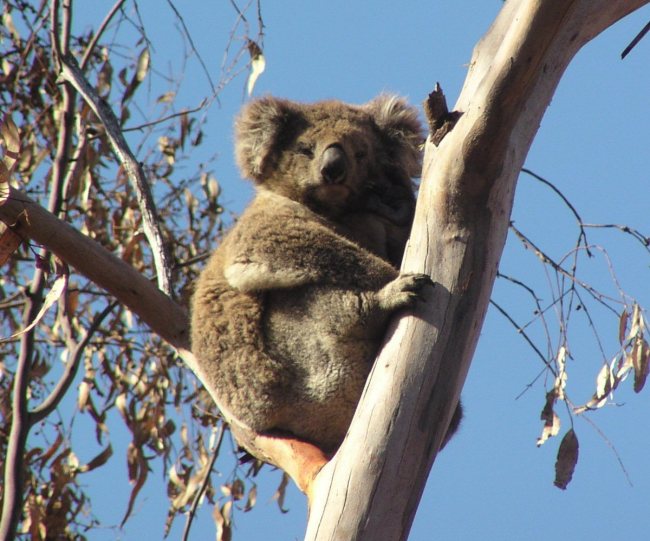Few people look up noses for a living. We do, and we’re proud of it! Luckily, koala’s noses are much nicer to look at than some noses…
wild male “Bear”
In the spring of 1998 I was walking along a gully looking for wild koalas for a group that were on their way to see them. I had located a male, who I’d seen several times before. At least, I think I’d seen him before – I really couldn’t be 100% sure. He looked about the same size, was in roughly the same area. But how to tell a big male koala from another big male koala? They all look the same really. Or do they?
So I studied this guy – grey fur, white belly, a bit brownish on the back – like every other koala I’d seen. Not much help. Look at the face, I thought. Then suddenly I saw it. White in the black nostrils. Different pattern in each nostril. Bingo.
Since then, we haven’t looked back. Turns out, we discovered a new method of identifying wild koalas. It has never failed us through whole lifetimes of koalas. Using it we set up our Koala Research Project.
wild female Ingrid, a survivor
Scruffy, Russell Crowe, Ingrid, Poppy, Daisy and her sons Lacka and Rudi, Bear, Clarence, Santa Barbara, Jamie and Garry Plant became part of our world. We learned so much from them. Then, after 7 happy years watching koalas in the Brisbane Ranges National Park, everything changed. A bushfire ripped through our koala area, killing 90% of them. Jamie, Bear and Ingrid were the only survivors.
Bear, back home
We had to find another area to visit for our tours, but we continued to monitor the Brisbane Ranges koalas for a year after the fire. Ingrid and Jamie lived full, long lives in their original home areas, even though it was burnt badly. Bear spent 3 weeks in hospital while his burnt feet healed, and was released back home, healthy and well. After about 6 months he left and presumably found a new home. He gave us an experience we had never dreamed of – close interaction with a wild koala during the capture and rehabilitation process. He demonstrated to all that he knew us, partly by giving me a “koala kiss” on our first meeting after the traumatic capture. He then gave us the best experience of all: to release a healthy wild koala back to their home.
the matriarch: Smoky
Our new koala research area was in the You Yangs Park, about 20 minutes away from the Brisbane Ranges. We found a thriving koala community there! There was the royal line: Smoky and her daughter Pat, and grandsons Pitta, Clancy and Banjo. There were the lovers: Karen and Merle; the battles: Vegemite vanquished Tim Tam, and then Anzac beat Vegemite; the movers: Vegemite, Vincent and Clancy, who all moved east to our new research area, and Nova, who moved west.
The Princess: Pat, with second son Clancy
There has been drought, fire and flooding. But through it all, our knowledge of wild koalas has grown, and our relationship with them has become stronger. With the help of our guests, we are now creating koala habitat in the You Yangs so that more wild koalas can live in safety.
We hope we have lots more to report in coming years!
wild male Buck
To those we have loved and lost, we thank you. Here they are:
BRISBANE RANGES:
Scruffy, Russell Crowe, Tess, Placid, Fran, Poppy, Garry Plant, Santa Barbara, Clarence, Maria, Constantine, Ingrid, Canada, Georgia and Calusa. Note: we don’t know if Ignatius, Rudi and Lacka were in the fire zone. We hope they survived. Daisy was found, alive and well, a few years ago with a baby!
YOU YANGS:
Grace, Boof, Calvin, Raini, Coal, Tim Tam, Xavier, Eureka, Emily, Mary, Svea, Karen, Zelda, Ngallo, Barak, Billibellary, Buck, Neerer, Oatsie, Vegemite and just recently, Smoky.
To those still making our lives richer today:
Aki, Aris, Anzac, Arne, Bandit, Berrijin, Benbo, Bundjalung, Bungaleenee, Clancy, Cloud, Carninje, Corrin, Cruiz, Darren, Derrimut, Elizabeth, Emma, Fairy, Kenny, Jin Jin, Mear, Moijerre, Marpeang, Nova, Pat, Truganina, Vincent, Wathaurong, Worinyaloke, Winberry,
and to those who’ve gone AWOL, may you be well:
Barere, Felicia, Leah, Kulpendurra, Nina, Pitta, Banjo, Sophie, Geisha, Keyeet, Parley, Tollora, Wenn, Casa, Kolain, Murrumbean and Wonga.






